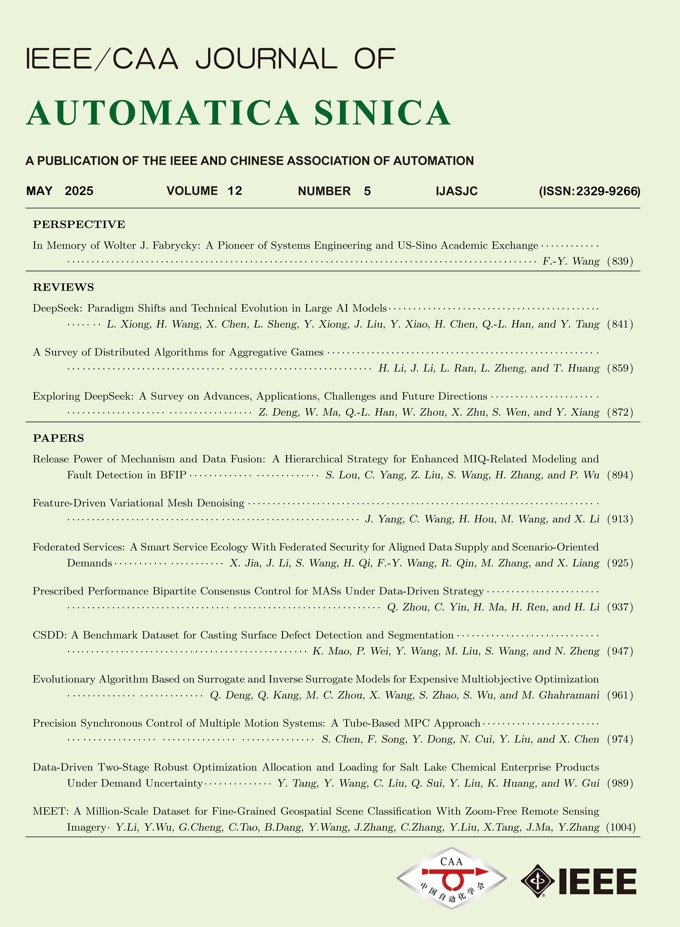 Volume 12
Issue 5
Volume 12
Issue 5
IEEE/CAA Journal of Automatica Sinica
| Citation: | B.-L. Xu, C. Peng, and W.-B. Xie, “Synchronous membership function dependent event-triggered H∞ control of T-S fuzzy systems under network communications,” IEEE/CAA J. Autom. Sinica, vol. 12, no. 5, pp. 1041–1043, May 2025. doi: 10.1109/JAS.2023.123729 |

| [1] |
X. Zhang, Q.-L. Han, X. Ge, B. Ning, and B. Zhang, “Sampled-data control systems with non-uniform sampling: A survey of methods and trends,” Annu. Rev. Control, vol. 55, pp. 70–91, 2023. doi: 10.1016/j.arcontrol.2023.03.004
|
| [2] |
D. Zhang, Q.-L. Han, and X. Zhang, “Network-based modeling and proportional-integral control for direct-drive-wheel systems in wireless network environments,” IEEE Trans. Cyber, vol. 50, no. 6, pp. 2462–2474, 2020. doi: 10.1109/TCYB.2019.2924450
|
| [3] |
T. Takagi and M. Sugeno, “Fuzzy identification of systems and its applications to modeling and control,” IEEE Trans. Syst. Man Cyber, vol. 15, no. 1, pp. 116–132, 1985.
|
| [4] |
C. Peng and M. R. Fei, “An improved result on the stability of uncertain T-S fuzzy systems with interval time-varying delay,” Fuzzy Sets Syst, vol. 212, pp. 97–109, 2013. doi: 10.1016/j.fss.2012.06.009
|
| [5] |
X. Jiang and Q.-L. Han, “On designing fuzzy controllers for a class of nonlinear networked control systems,” IEEE Trans. Fuzzy Syst, vol. 16, no. 4, pp. 1050–1060, 2008. doi: 10.1109/TFUZZ.2008.917293
|
| [6] |
J. Xing, C. Peng, Z. Cao, and W. Xie, “Security-based control for networked interval type-2 fuzzy systems with multiple cyber-attacks: An improved dynamic event-triggered scheme,” IEEE Trans. Fuzzy Syst., vol. 31, no. 8, pp. 2747–2760, 2023. doi: 10.1109/TFUZZ.2023.3235441
|
| [7] |
K. Tanaka and M. Sano, “A robust stabilization problem of fuzzy control systems and its application to backing up control of a truck-trailer,” IEEE Trans. Fuzzy Syst, vol. 2, no. 2, pp. 119–134, 1994. doi: 10.1109/91.277961
|
| [8] |
D. Kim and H. Lee, “Comments on “T-S fuzzy-model-based robust H∞ design for networked control systems with uncertainties”,” IEEE Trans. Ind. Inf., vol. 5, no. 4, p. 507, 2009.
|
| [9] |
H. Zhang, M. Li, J. Yang, and D. Yang, “Fuzzy model-based robust networked control for a class of nonlinear systems,” IEEE Trans. Syst. Man Cyber. Part A Syst. Humans, vol. 39, no. 2, pp. 437–447, 2009. doi: 10.1109/TSMCA.2008.2010787
|
| [10] |
E.G. Tian, D. Yue, and Z. Gu, “Robust H∞ control for nonlinear system over network: A piecewise analysis method,” Fuzzy Sets Syst, vol. 161, no. 21, pp. 2731–2745, 2010. doi: 10.1016/j.fss.2010.03.008
|
| [11] |
C. Peng, D. Yue, and M. Fei, “Relaxed stability and stabilization conditions of networked fuzzy control systems subject to asynchronous grades of membership,” IEEE Trans. Fuzzy Syst, vol. 22, no. 5, pp. 1101–1112, 2014. doi: 10.1109/TFUZZ.2013.2281993
|
| [12] |
C. Peng, M. Yang, J. Zhang, M. Fei, and S. Hu, “Network-based H∞ control for T-S fuzzy systems with an adaptive event-triggered communication scheme,” Fuzzy Sets Syst, vol. 329, pp. 61–76, 2017. doi: 10.1016/j.fss.2016.12.011
|
| [13] |
H. K. Lam, “A review on stability analysis of continuous-time fuzzy-model-based control systems: From membership-function-independent to membership-function-dependent analysis,” Eng. Appl. Artif. Intell, vol. 67, pp. 390–408, 2018. doi: 10.1016/j.engappai.2017.09.007
|
| [14] |
H. K. Lam, “Polynomial fuzzy-model-based control systems: Stability analysis via piecewise-linear membership functions,” IEEE Trans. Fuzzy Syst, vol. 19, no. 3, pp. 588–593, 2011. doi: 10.1109/TFUZZ.2011.2118215
|
 JAS-2023-0314-supp.pdf
JAS-2023-0314-supp.pdf
|

|